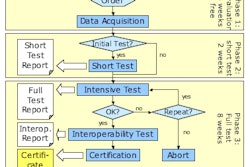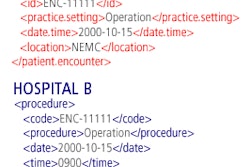A facility contemplating the implementation of an electronic health record (EHR) system would be foolish to deploy one that does not follow interoperability standards or has not been certified to do so by a recognized compliance organization, according to U.S. Department of Health and Human Services (HHS) Secretary Michael Leavitt in an address at the 2007 Healthcare Information Management Systems Society (HIMSS) conference in New Orleans earlier this month.
Although physically separated by the international date line and nearly 10,000 miles (16,000-plus kilometers), Australia's National E-Health Transition Authority (NEHTA) chief executive officer Dr. Ian Reinecke emphatically agrees with Secretary Leavitt's admonition for EHR systems to be standards-compliant.
According to Reinecke, NEHTA was formed as a recognition that e-health was moving too slowly, and incompatibly, across the Australian healthcare landscape, which encompasses nine states and territories with two-thirds of the care delivered by the public sector and the remaining third dispensed by private providers.
"Investments in health IT were uncoordinated across the public hospital system operated by the states," he said in a presentation at HIMSS. "There was a high penetration of computers in general practice, approximately 90%, but little desktop interoperability. Where messages were exchanged between clinical providers, there were no common formats, terminologies, or directories. And, multiple identifiers for patients and providers were in use across the primary and secondary sectors."
Australian healthcare rose to the challenge with the creation of NEHTA, a single entity that is developing national standards, specifications, terminologies, and formats to enable interoperability, as well as developing the national policies required to protect privacy and patient consent. In addition, Reinecke said that NEHTA will fund the missing pieces of infrastructure in healthcare identifiers and clinical terminology, and establish the basis for modeling e-health benefits to assist in assigning investment priorities.
According to Reinecke, the emphasis at NEHTA is the design of a national system of shared EHRs for authorized practitioners and the healthcare consumer.
The first benchmark that NEHTA expects to achieve is the full implementation of a national service to create a unique identifier that is HL7-compliant for Australia's 21 million citizens by the end of fiscal year 2008-2009. Funding for the program, $100 million Australian ($78.1 million U.S.) disbursed over a three-year period, has come from Council of Australian Governments (COAG), Reinecke said.
The shared EHR approach advocated by NEHTA seeks to build on existing clinical processes already in place, Reinecke noted.
"It will improve the availability of selected health information about individuals while providing effective privacy protection," he said. "It will support a more mobile population while saving clinicians time in seeking information and repeating tests; provide information for public health and policy planning, safety initiatives, disease detection, research, and education; and will allow better planning and demand management, improved epidemiology, and public health."
To achieve this auspicious goal, Reinecke said that NEHTA has recognized the need for a targeted approach to clinical terminologies used by providers in their health records.
"It's important that providers are able to exchange clinical information electronically, using a common language with consistent terms, descriptions, and formats," he said.
NEHTA has adopted SNOMED Clinical Terms (CT), a terminology that provides a common language that enables a consistent way of capturing, sharing, and aggregating health data across specialties and sites of care, as the foundation of its terminologies initiative.
As part of a long-term effort to build capacity in the health sector to support terminologies work through the provision of tools, training, and education, NEHTA is working on building Australian SNOMED extensions for pathology and radiology. It is also focused on the creation of Australian medicines and devices terminology, Reinecke said.
The emphasis on standards as the basis of Australia's e-health initiative will best enable an efficient and economical deployment of EHR capabilities throughout the country, Reinecke believes.
"A standards-based approach opens healthcare to the information and communications technology mainstream," he said. "In addition, foundations of common standards, identity services, and terminologies remove investment road blocks and increase opportunities for health IT vendors to build and deliver cross-sectoral e-health information services."
By Jonathan S. Batchelor
AuntMinnie.com staff writer
March 16, 2007
Related Reading
PACS developer offers image-enabled EHR guidance, March 1, 2007
Regulatory carve-outs hope to spur HIT growth in U.S., February 28, 2007
EHR deployment presents familiar obstacles, February 27, 2007
U.S. takes steps to ramp up HIT efforts, February 23, 2007
Security considerations in transmitting medical information, January 19, 2007
Copyright © 2007 AuntMinnie.com



















